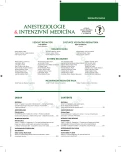-
Medical journals
- Career
Echocardiography for preload and fluid responsiveness assessment
Authors: F. Mošna
Authors‘ workplace: KARIM FN Motol a 2. LF UK, Praha
Published in: Anest. intenziv. Med., 26, 2015, č. 5, s. 280-284
Category:
Overview
Fluid administration is a basic therapeutic approach in patients with hypovolaemic circulatory failure. Inappropriate fluid resuscitation has serious and in some cases fatal consequences. To distinguish between volume responsive or non-responsive patients is one of the intensivist’s high priority tasks. Formerly used static parameters like CVP and PAOP are failing in this decision making. Echocardiography is offering an opportunity to monitor dynamic parameters (IVS and SVC diameter variation, maximal transaortic velocity and VTI) to identify the patients, which will profit from fluid administration. The necessity of mechanical ventilation is a limitation of this approach. PLRT can help with diagnosis in spontaneously breathing patients or in patients with arrhythmias.
Keywords:
echocardiography – preload – fluid responsiveness
Sources
1. De Backer, D. et al. Hemodynamic Monitoring Using Echocardiography in the Critically Ill. 1. vydání. 2011. 311 s. ISBN 978-3-540-87954-1.
2. Levitov, A., Marik, P. E. Echocardiographic Assessment of Preload Responsiveness in Critically Ill Patients. Cardiology Research and Practice, 2012, Article ID 819696, 7 p.
3. Feissel, M. et al. The respiratory variation in inferior vena cava diameter as a guide to fluid therapy. Intensive Care Medicine, 2004, 30, 9, p. 1834–1837.
4. Marik, P. E. et al. Stroke volume variations and fluid responsiveness. A systematic review of literature. Critical Care Medicine, 2009, 37, p. 2642–2647.
5. Blanco, P., Sasai, T. Assessment of left ventricle preload by transthoracic echocardiography: an easy task? Journal of Intensive Care, 2015, DOI 10.1186/s40560-015-0090-7.
6. Mohsenin, V. Assessment of preload and fluid responsiveness in intensive care unit. How good are we? Journal of Critical Care, 2015, 30, 3, p. 567–573.
7. Pinsky, M. R. Understanding preload reserve using functional hemodynamic monitoring. Intensive Care Medicine, March 2015. 10.1007/s00134-015-3744-y.
8. Lamia, B. Echocardiographic prediction of volume responsiveness in critically ill patients with spontaneously breathing activity. Intensive Care Medicine, 2007, 33, 7, p. 1125–1132.
Labels
Anaesthesiology, Resuscitation and Inten Intensive Care Medicine
Article was published inAnaesthesiology and Intensive Care Medicine

2015 Issue 5-
All articles in this issue
- Survey of transfusion practices in Jehovah’s Witnesses
- Comparison of heparin and citrate anticoagulation during continuous veno-venous haemodialysis (CVVHD) in critically ill children – prospective, crossover study
- Echocardiography for preload and fluid responsiveness assessment
- Practice advisory on anesthetic care for magnetic resonance imaging
- Patophysiology and diagnostics of anaphylactic syndrome of pregnancy
- The 140th anniversary of the opening of the “St. Apollinaire’s” National Maternity Hospital
- Anaesthesiology and Intensive Care Medicine
- Journal archive
- Current issue
- Online only
- About the journal
Most read in this issue- Comparison of heparin and citrate anticoagulation during continuous veno-venous haemodialysis (CVVHD) in critically ill children – prospective, crossover study
- Patophysiology and diagnostics of anaphylactic syndrome of pregnancy
- Echocardiography for preload and fluid responsiveness assessment
- Practice advisory on anesthetic care for magnetic resonance imaging
Login#ADS_BOTTOM_SCRIPTS#Forgotten passwordEnter the email address that you registered with. We will send you instructions on how to set a new password.
- Career

